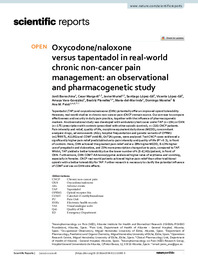Por favor, use este identificador para citar o enlazar este ítem:
https://hdl.handle.net/11000/32364Registro completo de metadatos
| Campo DC | Valor | Lengua/Idioma |
|---|---|---|
| dc.contributor.author | Barrachina, Jordi | - |
| dc.contributor.author | Margarit, César | - |
| dc.contributor.author | Muriel, Javier | - |
| dc.contributor.author | López‑Gil, Santiago | - |
| dc.contributor.author | López Gil, Vicente | - |
| dc.contributor.author | Vara-González, Amaya | - |
| dc.contributor.author | Planelles, Beatriz | - |
| dc.contributor.author | Inda, María del Mar | - |
| dc.contributor.author | Morales, Domingo | - |
| dc.contributor.author | Peiró, Ana | - |
| dc.contributor.other | Departamentos de la UMH::Farmacología, Pediatría y Química Orgánica | es_ES |
| dc.date.accessioned | 2024-06-27T11:35:56Z | - |
| dc.date.available | 2024-06-27T11:35:56Z | - |
| dc.date.created | 2022-06 | - |
| dc.identifier.citation | Scientifics Reports . 2022 Jun 16;12(1):10126. | es_ES |
| dc.identifier.issn | 2045-2322 | - |
| dc.identifier.uri | https://hdl.handle.net/11000/32364 | - |
| dc.description.abstract | Tapentadol (TAP) and oxycodone/naloxone (OXN) potentially offer an improved opioid tolerability. However, real-world studies in chronic non-cancer pain (CNCP) remain scarce. Our aim was to compare effectiveness and security in daily pain practice, together with the influence of pharmacogenetic markers. An observational study was developed with ambulatory test cases under TAP (n = 194) or OXN (n = 175) prescription with controls (prescribed with other opioids (control), n = 216) CNCP patients. Pain intensity and relief, quality of life, morphine equivalent daily doses (MEDD), concomitant analgesic drugs, adverse events (AEs), hospital frequentation and genetic variants of OPRM1 (rs1799971, A118G) and COMT (rs4680, G472A) genes, were analysed. Test CNCP cases evidenced a significantly higher pain relief predictable due to pain intensity and quality of life (R2 = 0.3), in front of controls. Here, OXN achieved the greatest pain relief under a 28% higher MEDD, 8-13% higher use of pregabalin and duloxetine, and 23% more prescription change due to pain, compared to TAP. Whilst, TAP yielded a better tolerability due the lower number of 4 [0-6] AEs/patient, in front of OXN. Furthermore, OXN COMT-AA homozygotes evidenced higher rates of erythema and vomiting, especially in females. CNCP real-world patients achieved higher pain relief than other traditional opioids with a better tolerability for TAP. Further research is necessary to clarify the potential influence of COMT and sex on OXN side-effects. | es_ES |
| dc.format | application/pdf | es_ES |
| dc.format.extent | 12 | es_ES |
| dc.language.iso | eng | es_ES |
| dc.publisher | Nature Portfolio | es_ES |
| dc.rights | info:eu-repo/semantics/openAccess | es_ES |
| dc.rights.uri | http://creativecommons.org/licenses/by-nc-nd/4.0/ | * |
| dc.subject | Genetics | es_ES |
| dc.subject | Neuroscience | es_ES |
| dc.subject | Medical research | es_ES |
| dc.subject | Biomarkers | es_ES |
| dc.subject | Predictive markers | es_ES |
| dc.subject | Prognostic markers | es_ES |
| dc.subject.other | CDU::6 - Ciencias aplicadas::61 - Medicina::615 - Farmacología. Terapéutica. Toxicología. Radiología | es_ES |
| dc.title | Oxycodone/naloxone versus tapentadol in real-world chronic non-cancer pain management: an observational and pharmacogenetic study | es_ES |
| dc.type | info:eu-repo/semantics/article | es_ES |
| dc.relation.publisherversion | https://doi.org/10.1038/s41598-022-13085-5 | es_ES |

Ver/Abrir:
Oxycodonenaloxone - naloxone versus tapentadol in real-world chronic non-cancer pain management.an observational and pharmacogenetic study.pdf
1,61 MB
Adobe PDF
Compartir:
 La licencia se describe como: Atribución-NonComercial-NoDerivada 4.0 Internacional.
La licencia se describe como: Atribución-NonComercial-NoDerivada 4.0 Internacional.
.png)